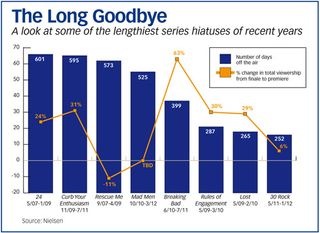Absence May Make 'Mad Men'Viewers Grow Fonder

On March 25—after 525 excruciating days of waiting—fans of Mad Men will finally be treated to the premiere of the drama’s fifth season. And if their own ad campaign worked, AMC executives will themselves be treated to some good news when the ratings come out.
Series hiatuses are commonplace in the TV world, caused by anything from production delays to writers’ strikes to low ratings to a creator’s whims (in the case of The Sopranos). But historically, many series that have gone on extended hiatuses—for reasons other than waning viewership— have benefited from the break in the form of increased ratings for their long-anticipated returns.
Judging such a bounce is of course not an exact science— there are many factors that can affect a series’ viewership after a long break, including premiering in a different month or time period (Breaking Bad, 30 Rock) or in some cases, entering a final season (Lost). MadMen will have a March premiere instead of its customary July date, but AMC execs are expecting the show’s cult-like following to return despite the change of season.
“I honestly think the Mad Men audience is among the most devoted audiences in television,” Joel Stillerman, AMC executive VP of original programming, production and digital content, said at a Hollywood Radio & Television Society event this month. “While it’s never easy to make scheduling decisions that keep a show off the air longer than perhaps you’d like, I think it’s going to benefit the show in the long run.”
In the seven recent series studied for this story, six came back from longer than normal breaks between seasons to a larger premiere audience. Though that is not to say that a bump in premiere ratings cannot drop off later in the season, as viewers who initially returned choose not to tune in week after week.
Mad Men’s 17-month hiatus was a side effect of AMC’s decision to move the ascendant Breaking Bad to the summer, a shift that helped that series’ viewership grow 63% from its season three finale to its season four premiere, including a gain of 48% in the key adults 18-49 demographic, after it was off the air for more than a year.
Also working in Mad Men’s favor is the multiyear licensing deal its studio, Lionsgate, inked with Netflix to stream the first four seasons of the series starting last July, allowing new viewers to catch up on past seasons or ardent fans to re-watch in anticipation. (Past seasons of Breaking Bad were not available on Netflix until two months after its return.)
“[Mad Men] may be helped by Netflix picking it up and people having the ability to spend a whole day watching a season on demand,” said Brad Adgate, senior VP of research at Horizon Media.
When we left Don Draper and company, he had just made a surprise proposal to his secretary in a finale episode that drew 2.4 million total viewers—Mad Men’s mark to match this Sunday. As Draper said in a 2007 episode, nostalgia is “delicate, but potent”—and nostalgic fans could prove to be just that for the series’ premiere ratings.
E-mail comments to amorabito@nbmedia.com and follow her on Twitter: @andreamorabito
Broadcasting & Cable Newsletter
The smarter way to stay on top of broadcasting and cable industry. Sign up below
